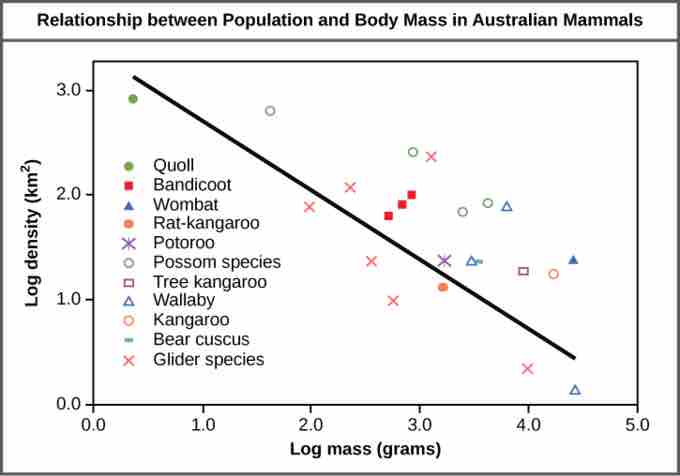Population size and density
Population size and density are the two most important statistics scientists use to describe and understand populations. A population's size refers to the number of individuals (N) it comprises. Its density is the number of individuals within a given area or volume. These data allow scientists to model the fluctuations of a population over time. For example, a larger population may be more stable than a smaller population. With less genetic variation, a smaller population will have reduced capacity to adapt to environmental changes. Individuals in a low-density population are thinly dispersed; hence, they may have more difficulty finding a mate compared to individuals in a higher-density population. On the other hand, high-density populations often result in increased competition for food. Many factors influence density, but, as a rule-of-thumb, smaller organisms have higher population densities than do larger organisms .

Population density is negatively correlated with body size
Australian mammals show a typical inverse relationship between population density and body size.
Population research methods
Counting all individuals in a population is the most accurate way to determine its size. However, this approach is not usually feasible, especially for large populations or extensive habitats. Instead, scientists study populations by sampling, which involves counting individuals within a certain area or volume that is part of the population's habitat. Analyses of sample data enable scientists to infer population size and population density about the entire population.
A variety of methods can be used to sample populations. Scientists usually estimate the populations of sessile or slow-moving organisms with the quadrat method . A quadrat is a square that encloses an area within a habitat. The area may be defined by staking it out with sticks and string, or using a square made of wood, plastic, or metal placed on the ground.
Scientist uses a quadrat to measure plant population size and density
A quadrat is a square frame of known area in which species of interest can be easily counted and measured.
A field study usually includes several quadrat samples at random locations or along a transect in representative habitat. After they place the quadrats, researchers count the number of individuals that lie within the quadrat boundaries. The researcher decides the quadrat size and number of samples from the type of organism, its spatial distribution, and other factors. For sampling daffodils, a 1 m2 quadrat could be appropriate. Giant redwoods are larger and live further apart from each other, so a larger quadrat, such as 100 m2, would be necessary. The correct quadrat size ensures counts of enough individuals to get a sample representative of the entire habitat.
Scientists typically use the mark and recapture technique for mobile organisms such as mammals, birds, or fish . With this method, researchers capture animals and mark them with tags, bands, paint, body markings, or some other sign. The marked animals are then released back into their environment where they mix with the rest of the population. Later, a new sample is collected, including some individuals that are marked (recaptures) and some individuals that are unmarked.
Mark and recapture is used to measure the population size of mobile animals.
With the mark and recapture method, researchers capture animals and mark them with tags, bands, paint, body markings or some other sign.
The ratio of marked to unmarked individuals allows scientists to calculate how many individuals are in the population as an estimate of total population size. This method assumes that the larger the population, the lower the percentage of tagged organisms that will be recaptured since they will have mixed with more untagged individuals. For example, if 80 deer are captured, tagged, and released into the forest, and later 100 deer are captured with 20 of them are already marked, we can determine the population size (N) using the following equation:
Plugging the example data into the equation, the calculation gives an estimated total population size of 400.
Using the example data, if only 10 already-marked deer had been recaptured, the calculated total population size would be 800.
The mark and recapture method has limitations. Some animals from the first catch may learn to avoid capture in the second round. Such behavior would cause inflated population estimates. Alternatively, animals may preferentially be retrapped (especially if a food reward is offered), resulting in an underestimate of population size. Also, some species may be harmed by the marking technique, reducing their survival. A variety of other techniques have been developed, including the electronic tracking of animals tagged with radio transmitters and the use of data from commercial fishing and trapping operations to estimate the size and health of populations and communities.